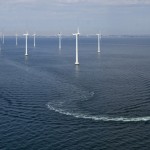 Wind energy opponents who say that producing electricity using the power of the wind is not efficient would do well to take a look at a new graphic published on the Guardian’s data blog using UK Government data. ‘Up in smoke: how energy efficient is electricity produced in the UK?’ shows that thermal sources of electricity – gas, coal, nuclear, waste/biomass, oil and other – lose massive amounts of energy as waste heat, compared to almost 0% for renewables.
Wind energy opponents who say that producing electricity using the power of the wind is not efficient would do well to take a look at a new graphic published on the Guardian’s data blog using UK Government data. ‘Up in smoke: how energy efficient is electricity produced in the UK?’ shows that thermal sources of electricity – gas, coal, nuclear, waste/biomass, oil and other – lose massive amounts of energy as waste heat, compared to almost 0% for renewables.
Gas accounts for 48% of the UK’s electricity supply and, of the 372 Terra-Watt hours of electricity it produces per year, 54% of this is lost as heat. Coal, meanwhile, accounts for 28% producing 297 TWh, loses an even higher proportion – 66%. Nuclear – accounting for 16% of the energy supply with 162 TWh, loses 65% and oil – 3% of the supply with 51 TWh – loses 77%.
 People can expect a catastrophic 50% global increase in greenhouse gas (GHG) emissions and worsening air pollution by 2050 unless politicians rapidly work together to find sustainable growth policies, a new report by the OECD has found.
People can expect a catastrophic 50% global increase in greenhouse gas (GHG) emissions and worsening air pollution by 2050 unless politicians rapidly work together to find sustainable growth policies, a new report by the OECD has found.
The Organisation for European Economic Co-operation report also noted that world energy demand in less than four decades could be 80% higher and still 85% reliant on fossil fuel-based energy unless radically new development paths are chosen.
The OECD warned governments take action now to prevent irreversible environmental damage even as they struggle with the ongoing financial crisis and high unemployment.
 Talks aimed at reaching a new international agreement to limit and then reduce emissions caused by greenhouse gases were set to ramp up to a higher level today as national environment ministers joined the ongoing negotiations in Cancun.
Talks aimed at reaching a new international agreement to limit and then reduce emissions caused by greenhouse gases were set to ramp up to a higher level today as national environment ministers joined the ongoing negotiations in Cancun.
Remi Gruet, the European Wind Energy Association’s regulatory affairs advisor who is attending the two-week-long United Nations Framework Convention on Climate Change (UNFCCC) conference, said Monday that observers are wondering if the ministers can take the negotiations to a higher level than the first week of talks.
“The mood of many negotiators now is they don’t know what to do,” Gruet told me.
 A number of prominent members of the Navajo Nation, the largest tribe in the US, are beginning to advocate that economic activity created by wind power and other renewables should begin replacing coal mining on the band’s huge reservation, according to The New York Times.
A number of prominent members of the Navajo Nation, the largest tribe in the US, are beginning to advocate that economic activity created by wind power and other renewables should begin replacing coal mining on the band’s huge reservation, according to The New York Times.
Carrying the headline “Navajos Hope to Shift From Coal to Wind and Sun”, the NYT story also said that people are increasingly wondering about health and environmental concerns caused by coal mining and coal-fired power plants on the reservation that sprawls across parts of New Mexico, Utah and Arizona.
Published on Monday, the article noted some of the 300,000 people in the Navajo Nation — which covers about 70,000 square kilometers — are now speaking out against the smog, soot, water pollution and health problems long associated with the coal industry.
By guest blogger, Tuuliki Kasonen-Lins
Estonian Wind Power Association
 Recently there have been several articles in the Estonian media concerning the excessive price of renewable energy that consumers have to pay, and giving the cause as the highly expensive investments in wind energy. It has been forgotten though that every new power plant needs subsidising and wind farms have been the only power plants built in our country in recent years. Indeed, the investments in oil shale plants constructed during Soviet times do not appear on the energy bills of today’s consumers.
Recently there have been several articles in the Estonian media concerning the excessive price of renewable energy that consumers have to pay, and giving the cause as the highly expensive investments in wind energy. It has been forgotten though that every new power plant needs subsidising and wind farms have been the only power plants built in our country in recent years. Indeed, the investments in oil shale plants constructed during Soviet times do not appear on the energy bills of today’s consumers.
The Estonian Parliament recently validated the subsidies for two new oil shale plants (600MW), which proves that every new power plant needs financial support from the Government for the period of repaying long-term loans. Otherwise such huge investments would not be made and power plants would not be built. Subsidies are also given to cogeneration (CHP) and biomass plants. Newcomers just cannot compete with the existing competitors in the free electricity market. Therefore the discussion cannot be only about subsidising wind farms but also every other new power plant.
However, we should bear in mind the fact that subsidising wind energy is temporary – only during the first 12 years- and after that it will be the cheapest production method of energy in the market. The subsidising period of new oil shale plants planned in Estonia lasts for 20 years and unlike with wind farms it has to be paid even during the time when the plant is not generating electricity. For example, if the high taxation of CO2 emissions drives up the price of oil shale and new oil shale plants cannot sell electricity on the market, they will still be subsidised.
 Wind energy opponents who say that producing electricity using the power of the wind is not efficient would do well to take a look at a new graphic published on the Guardian’s data blog using UK Government data. ‘Up in smoke: how energy efficient is electricity produced in the UK?’ shows that thermal sources of electricity – gas, coal, nuclear, waste/biomass, oil and other – lose massive amounts of energy as waste heat, compared to almost 0% for renewables.
Wind energy opponents who say that producing electricity using the power of the wind is not efficient would do well to take a look at a new graphic published on the Guardian’s data blog using UK Government data. ‘Up in smoke: how energy efficient is electricity produced in the UK?’ shows that thermal sources of electricity – gas, coal, nuclear, waste/biomass, oil and other – lose massive amounts of energy as waste heat, compared to almost 0% for renewables.






 Comments
Comments



